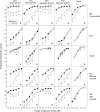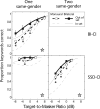Having Two Ears Facilitates the Perceptual Separation of Concurrent Talkers for Bilateral and Single-Sided Deaf Cochlear Implantees
- PMID: 26886027
- PMCID: PMC4869863
- DOI: 10.1097/AUD.0000000000000284
Having Two Ears Facilitates the Perceptual Separation of Concurrent Talkers for Bilateral and Single-Sided Deaf Cochlear Implantees
Abstract
Objectives: Listening to speech with multiple competing talkers requires the perceptual separation of the target voice from the interfering background. Normal-hearing listeners are able to take advantage of perceived differences in the spatial locations of competing sound sources to facilitate this process. Previous research suggests that bilateral (BI) cochlear-implant (CI) listeners cannot do so, and it is unknown whether single-sided deaf (SSD) CI users (one acoustic and one CI ear) have this ability. This study investigated whether providing a second ear via cochlear implantation can facilitate the perceptual separation of targets and interferers in a listening situation involving multiple competing talkers.
Design: BI-CI and SSD-CI listeners were required to identify speech from a target talker mixed with one or two interfering talkers. In the baseline monaural condition, the target speech and the interferers were presented to one of the CIs (for the BI-CI listeners) or to the acoustic ear (for the SSD-CI listeners). In the bilateral condition, the target was still presented to the first ear but the interferers were presented to both the target ear and the listener's second ear (always a CI), thereby testing whether CI listeners could use information about the interferer obtained from a second ear to facilitate perceptual separation of the target and interferer.
Results: Presenting a copy of the interfering signals to the second ear improved performance, up to 4 to 5 dB (12 to 18 percentage points), but the amount of improvement depended on the type of interferer. For BI-CI listeners, the improvement occurred mainly in conditions involving one interfering talker, regardless of gender. For SSD-CI listeners, the improvement occurred in conditions involving one or two interfering talkers of the same gender as the target. This interaction is consistent with the idea that the SSD-CI listeners had access to pitch cues in their normal-hearing ear to separate the opposite-gender target and interferers, while the BI-CI listeners did not.
Conclusions: These results suggest that a second auditory input via a CI can facilitate the perceptual separation of competing talkers in situations where monaural cues are insufficient to do so, thus partially restoring a key advantage of having two ears that was previously thought to be inaccessible to CI users.
Figures




References
-
- Arbogast TL, Mason CR, Kidd G. The effect of spatial separation on informational and energetic masking of speech. J Acoust Soc Am. 2002;112:2086–2098. - PubMed
-
- Arndt S, Aschendorff A, Laszig R, et al. Comparison of pseudo-binaural hearing to real binaural hearing rehabilitation after cochlear implantation in patients with unilateral deafness and tinnitus. Otol Neurotol. 2011;32:39–47. - PubMed
-
- Bernstein JGW, Iyer N, Brungart DS. Release from informational masking in a monaural competing-speech task with vocoded copies of the maskers presented contralaterally. J Acoust Soc Am. 2015;137:702–713. - PubMed
-
- Blamey P, Artieres F, Başkent D, et al. Factors affecting auditory performance of postlinguistically deaf adults using cochlear implants: An update with 2251 patients. Audiol Neurootol. 2013;18:36–47. - PubMed
-
- Blauert J, Lindemann W. Auditory spaciousness: Some further psychoacoustic analysis. J Acoust Soc Am. 1986;80:533–542. - PubMed
MeSH terms
Grants and funding
LinkOut - more resources
Full Text Sources
Other Literature Sources
Medical
Miscellaneous

